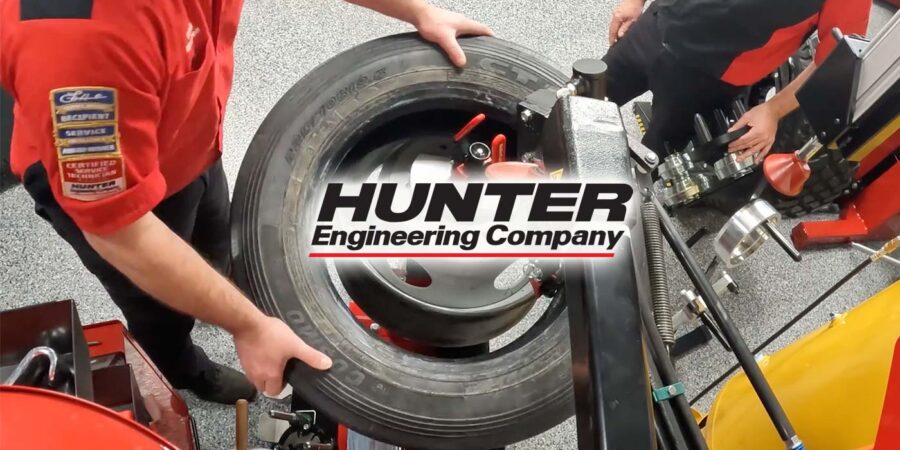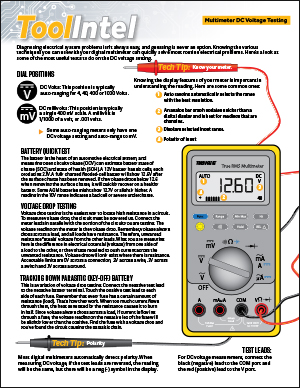By Larry Carley
These days, no matter what kind of automotive repair work you specialize in, virtually every system has a certain amount of electronics. Consequently, one diagnostic tool every technician needs is a digital multimeter.
To figure out electrical and electronic problems, you have to “see” what’s going on inside the circuits and components. Trouble is, you can’t see electrons because they are invisible. That’s why you need a diagnostic tool that can measure the movement of electrons in circuits and components to make the invisible visible.
 A digital multimeter (DMM) or digital volt ohm meter (DVOM) typically combines the functions of a voltmeter, ohmmeter and ammeter into one. It can display voltage readings, resistance (ohms) readings, and amperage (current) readings. Some of the better units can also display frequency and dwell, as well as pressure and temperature with the appropriate probes.
A digital multimeter (DMM) or digital volt ohm meter (DVOM) typically combines the functions of a voltmeter, ohmmeter and ammeter into one. It can display voltage readings, resistance (ohms) readings, and amperage (current) readings. Some of the better units can also display frequency and dwell, as well as pressure and temperature with the appropriate probes.
Why digital? For precision and protection. A digital display is usually easier to read and less confusing than a needle on an analog meter (which may have multiple scales printed on it). A digital display can also read to tenths or even hundredths of a volt or amp. Most digital multimeters also have a 10 megohm impedance built into the test circuit so the tester won’t overload or damage sensitive electronic components. To measure resistance, an ohmmeter applies a small current to the circuit being tested. If the applied current is too great, there is a risk of damaging an electronic component. You don’t need a high impedance 10 megohm multimeter when testing 12-volt electrical circuits, but you do when testing low voltage electronic circuits, sensors and modules.
An analog meter, by comparison, is better than a digital meter for displaying changing or fluctuating voltage, resistance and current readings. It’s easier to watch the needle sweep back and forth on an analog meter than to watch rapidly changing numbers on a digital display. So each type of meter is best suited to a different type of application.
A digital reading may also totally miss a sudden change in voltage, resistance or current that occurs too quickly for the meter to detect and display it. There’s always a slight lag in what the tester reads and what it displays, and depending on the refresh rate of the display it may miss some changes completely. So for rapidly changing values, a digital storage oscilloscope (DSO) or graphing multimeter (GMM) is a better tool.
GRAPHING MULTIMETERS
Think of a graphing multimeter as a DMM with pictures. It can display voltage, resistance, current and frequencies as a waveform. A graphing multimeter displays voltage on the vertical scale and time along the horizontal scale. When you select the graphing function, the unit begins to record the input signal and display it as a graph similar to a strip-chart recorder.
Seeing the voltage, resistance, current or frequency as a waveform on a screen instead of a rapidly changing number on a digital display makes it easier to tell if a sensor or circuit is functioning normally or not. For one thing, you can spot a bad waveform in an instant if you know what to look for. Some graphing multimeters have an electronic library of known-good signals for comparison. Some even include wiring diagrams and a vehicle-specific database of diagnostic and test information.
You also can compare several waveforms at the same time if the graphing multimeter has “dual trace” or “multiple trace” capability. This can be very useful when checking the oxygen sensor’s response or changes in injector duration against inputs from other sensors such as the MAP sensor, airflow sensor, throttle position sensor or coolant sensor.
Changing the time base on a graphing multimeter can compress or stretch the waveform trace to suit the type of test being performed. The upper and lower viewing limits can also be changed by using the cursor to set the values.
Waveform libraries are available from numerous sources, including the International Automotive Technicians Network (iATN) website: www.iatn.net.
PROBES & ASSESSORIES
All multimeters come with a basic set of probes for testing circuits and components. But the standard probes may not be the right size or shape to backprobe tight-fitting connectors or other hard-to-reach components. So you should also buy a variety of probes including ones with extra-small tips for backprobing connectors and getting into tight spaces.
Another type of probe to consider is one that can grip or lock onto a connector or wire. Self-gripping probes can free up your hands so you don’t have to hold the probes and meter and wiggle wires, goose the throttle or do something else at the same time.
For measuring current, you will need an inductive amp probe that clamps around a wire. These come in various amp ratings, so you may need several depending on what you are attempting to measure.
Many multimeters also can be attached to a temperature probe or a pressure probe. These special probes typically convert a temperature or pressure value into a voltage reading.
PRICES & CAPABILITIES
The capabilities of a multimeter are usually reflected in its price. A simple $29.95 multimeter obviously isn’t in the same league with one that costs $400 or more. The differences are in the accuracy of the tool, the display capabilities of the tool, and the durability of the tool.
Higher end multimeters typically have autoranging displays, more features (such as minimum/maximum recording, the ability to store and download data to a PC, etc.), additional probes (temperature and pressure/vacuum) and a better warranty.
Some multimeters have additional test functions to check diodes, an audible or visual continuity indicator, built-in LED lights (called noid lights) to indicate low amperage current within a circuit (as when checking fuel injectors or a Hall effect crankshaft position sensor). Some multimeters also can display more than one test value at a time for comparison purposes, and some can even measure ignition voltages (kilovolts or kV) to check ignition output.
Another feature you might want in a multimeter is the ability to “simulate” voltage and frequency signals. Some tools can simulate a rich or lean oxygen sensor signal to check the feedback circuit in the engine management system.
Some meters also have a “glitch” capture mode that can help you capture dropouts in a throttle position sensor or other sensor. So before you buy a multimeter, shop and compare features. Then select one or more meters that will best suit the kind of work you do. Many technicians own several multimeters. They may have an inexpensive basic DVOM for making quick checks and one or more higher end models for situations that require more advanced capabilities and diagnostic work.














